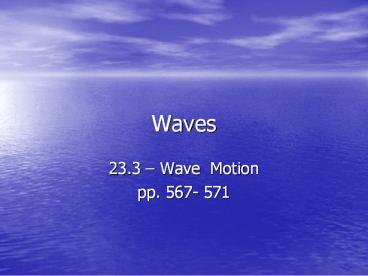Waves - PowerPoint PPT Presentation
1 / 13
Title:
Waves
Description:
Waves 23.3 Wave Motion pp. 567- 571 23.3 Wave Motion A wave front is the leading edge of a moving wave which is considered to be the crest for purposes of modeling. – PowerPoint PPT presentation
Number of Views:178
Avg rating:3.0/5.0
Title: Waves
1
Waves
- 23.3 Wave Motion
- pp. 567- 571
2
23.3 Wave Motion
- A wave front is the leading edge of a moving wave
which is considered to be the crest for purposes
of modeling. - The crests of a plane wave look like parallel
lines. - The crests of a circular wave are circles.
3
23.3 Four wave interactions
- When a wave encounters a surface, four
interactions can occur - reflection,
- refraction,
- diffraction, or
- absorption.
4
23.3 Wave interactions
- A boundary is an edge or surface where things
change. - Reflection, refraction, and diffraction usually
occur at boundaries.
5
REFRACTION
- The bending of a wave as it passes at an angle
from one medium to another is called refraction. - The speed of a wave changes depending on the
medium in which it is traveling
6
23.3 Wave interactions
- Diffraction usually changes the direction and
shape of the wave. - When a plane wave passes through a small hole
diffraction turns it into a circular wave.
7
23.3 Wave interactions
- Absorption is what happens when the amplitude of
a wave gets smaller and smaller as it passes
through a material. - The wave energy is transferred to the absorbing
material. - Curtains in theaters absorb backstage sounds so
the audience doesnt hear them.
8
23.3 Transverse waves
- The oscillations of a transverse wave are not in
the direction the wave moves. They are
perpendicular to the direction of the wave
movement.
9
23.3 Longitudinal waves
- The oscillations of a longitudinal wave are in
the same direction that the wave moves.
10
23.3 Constructive interference
- Constructive interference happens when waves add
up to make a larger amplitude. - Suppose you make two wave pulses on a stretched
string. - One comes from the left and the other comes from
the right. - When the waves meet, they combine to make a
single large pulse.
11
(No Transcript)
12
23.3 Destructive interference
- What happens when one pulse is on top of the
string and the other is on the bottom? - When the pulses meet in the middle, they cancel
each other out. - During destructive interference, waves add up to
make a wave with smaller or zero amplitude.
13
(No Transcript)































